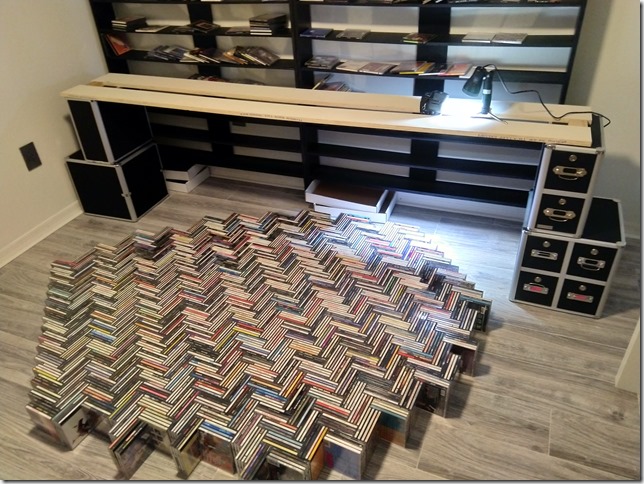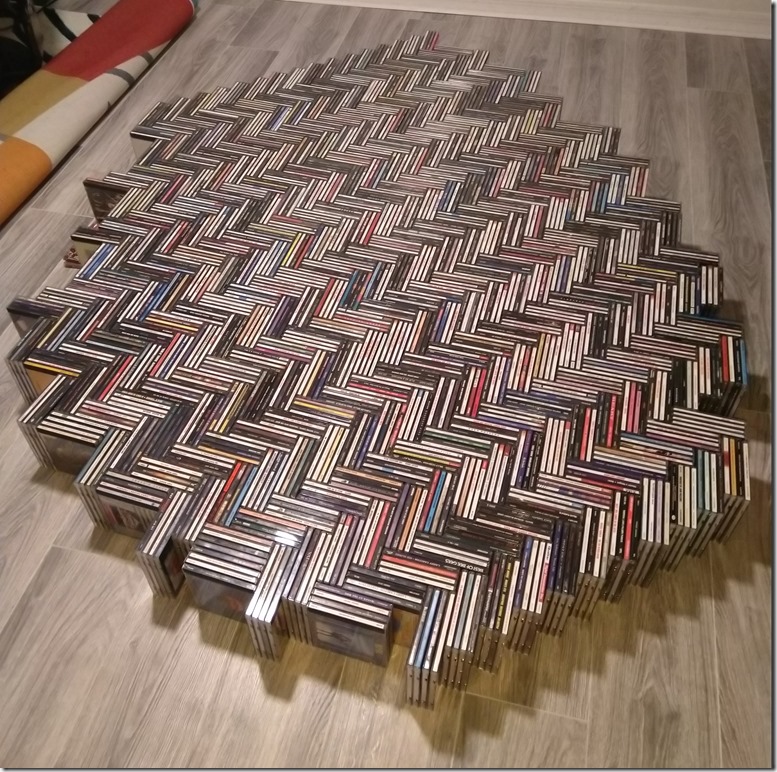There’s really a stigma against failure, especially in America. It is expected that you keep trying until you succeed, regardless of the consequences of doing so. While my tale of defeat is nothing of consequence, with little to really be lost from non-success, it kind of makes me sad for people who are not given the opportunity to fail. And further, to even classify the result as failure when it really should not be.
A week or so ago, I replicated a piece of artwork I have in my house, using my CD collection instead of the cassette tapes that were used in the art. The picture of the CDs turned out pretty good, I thought, and I was inspired to grow it to a massive scale. Where my original picture had maybe a couple hundred CDs featured in it, I wanted to scale it up to most of my collection, somewhere on the order of 1500+ CDs.

Over a series of nights, I spent my time placing the CDs in the pattern on the floor. Keeping the pattern correct and also trying to make sure the CDs varied enough in their grouping was a little arduous. But, I did persist and came up with a very large, organized mess of CDs. Then the challenge became how to capture it.
I have a fair collection of photography equipment and so I was able to do some experimentation. Experimentation was all I could do because I really had no idea how to accomplish the task. The first attempt was to capture as much as possible in one picture. I held the camera above the arrangement using a tripod and the self-timed shutter. This kind of worked except when you would zoom in, you couldn’t read any of the CD spines. So, in other words, it didn’t work at all.
The real solution would be to take multiple photos and stitch them together. So, that was my next attempt. I scanned one row of CDs and took a series of pictures, then took them to the computer to mate them up. That proved to be very difficult because each picture had to be adjusted to compensate for rotation and zoom and also lighting. This was proving to be a non-solution as well. I had a massive number of CDs arranged on my floor and I was running out of ideas to photograph them.
Since the problem with my stitching/panorama concept was consistency, I came up with the idea that I could build a trolly-type of rig to suspend the camera over the arrangement. This would keep the camera at a constant height and angle where each picture would be the same. It was a pretty clever idea and made me feel pretty inventive.

So I went to work assembling the rig and shot the first row of CDs. I took the pictures to the computer and stitching them was actually pretty simple. This was promising. I evaluated the size of the arrangement and determined I would have nine rows of photos to stitch up. This would take days, certainly. But that’s ok, as long as I made progress.
I shot the second row of photos and brought them in for stitching. Suddenly, things weren’t lining up anymore. The first couple photos worked out, then all of a sudden, the scale didn’t fit any more. Thinking I must’ve shifted the camera somewhere along the way, I re-shot the row of photos. Again, at the same place, the photos failed to line up. I wasn’t sure if it was the first row of photos that were somehow misaligned and causing the second row to not match up, or maybe it was just something that was intrinsic to the photos themselves. I was noticing there was a slight fish-eye effect from the 35mm lens I was using, so the CDs on the periphery of the photos were skewed from the ones in the center. As I would line up the images on the outer edges, they would be distorted from the ones trying to be matched in the center.
At this point, I had had my CD collection completely dismantled, on the floor, for a week. This was causing me a little bit of stress. I was unable to use my listening room for any listening because the floor was consumed with this arrangement. I was adding new CDs to my collection, but they were in a separate stack, not integrated yet. My patience was running low, and my prospects of success were low as well.
The next thing to attempt would be to use my 50mm lens on the camera, which wouldn’t fish-eye as much, but that would take much closer images of the CDs, unless I built the rig even higher up, which I wasn’t too keen to do. So, I accepted failure and began the process of dismantling and reorganization.
And the point here, accepting failure, is the key. "Failing", or "giving up", is not a bad thing. There are plenty of other phrases that exist to make yourself feel better about the situation, like "cutting your losses", and something about "reward vs. effort". those phrases get closer to the reality of the situation. Right now, this is not something I want to tackle. It was a good idea, and one I may revisit in the future with an improved vision and more commitment, but I want a return to stability. There would be no way I could clear my mind enough to consider any means of improvement with everything all out like that.
In the next iteration, if there is one, I would definitely test out some techniques on smaller arrangements, instead of committing fully to a full collection dissection. That was days of effort to dismantle and it will be days to reassemble, too. So until next time, fail on.

Comments are closed.